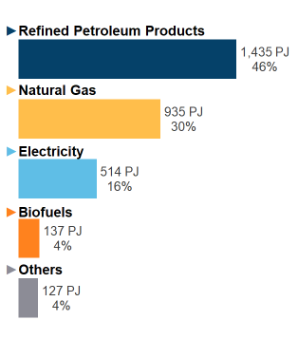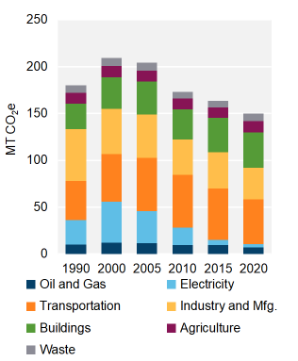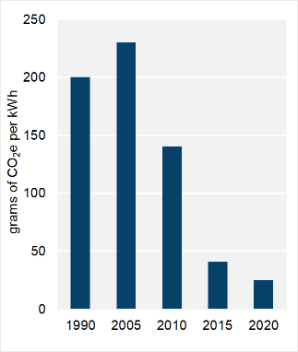Provincial and Territorial Energy Profiles – Ontario

On this page:
Connect/Contact Us
Please send comments, questions, or suggestions to
energy-energie@cer-rec.gc.ca
-
Figure 1: Hydrocarbon Production
Source and Description:
Source:
CER – Estimated Production of Canadian Crude Oil and Equivalent and Marketable Natural Gas Production in CanadaDescription:
This graph shows hydrocarbon production in Ontario from 2013 to 2023. Over this period, crude oil production has decreased from 1.3 Mb/d to 0.5 Mb/d. Natural gas production has deceased from 12.3 MMcf/d to 6.2 MMcf/d. -
Figure 2: Electricity Generation by Fuel Type (2021)
Source and Description:
Source:
CER – Canada's Energy Future 2023 Data Appendix for Electricity GenerationDescription:
This pie chart shows electricity generation by source in Ontario. A total of 148.3 TWh of electricity was generated in 2021. -
Figure 3: Crude Oil Infrastructure Map
Source and Description:
Source:
CERDescription:
This map shows major CER-regulated crude oil pipelines, rail lines, and refineries in Ontario.Download:
PDF version [1,940 KB] -
Figure 4: Natural Gas Infrastructure Map
Source and Description:
Source:
CERDescription:
This map shows major CER-regulated natural gas pipelines in Ontario.Download:
PDF version [1,413 KB] -
Figure 5: End-Use Demand by Sector (2020)
Source and Description:
Source:
CER – Canada's Energy Future 2023 Data Appendix for End-Use DemandDescription:
This pie chart shows end-use energy demand in Ontario by sector. Total end-use energy demand was 2,751 PJ in 2020. The largest sector was industrial at 36% of total demand, followed by transportation (at 26%), residential (at 19%), and lastly, commercial (at 18%). -
Figure 6: End-Use Demand by Fuel (2020)
Source and Description:
Source:
CER – Canada's Energy Future 2023 Data Appendix for End-Use DemandDescription:
This figure shows end-use demand by fuel type in Ontario in 2020. Refined petroleum products accounted for 1,155 PJ (42%) of demand, followed by natural gas at 856 PJ (31%), electricity at 498 PJ (18%), biofuels at 142 PJ (5%), and other at 101 PJ (4%).
Note: "Other" includes coal, coke, and coke oven gas. -
Figure 7: GHG Emissions by Sector
Source and Description:
Source:
Environment and Climate Change Canada – National Inventory Report 1990-2022Description:
This stacked column graph shows GHG emissions in Ontario by sector from 1990 to 2022 in MT of CO2e. Total GHG emissions have decreased in Ontario from 178 MT of CO2e in 1990 to 157 MT of CO2e in 2022. -
Figure 8: Emissions Intensity from Electricity Generation
Source and Description:
Source:
Environment and Climate Change Canada – National Inventory Report 1990-2022Description:
This column graph shows the emissions intensity of electricity generation in Ontario from 1990 to 2022. In 1990, electricity generated in Ontario emitted 200 g of CO2e per kWh. By 2022, emissions intensity decreased to 35 g of CO2e per kWh.
Energy Production
Crude Oil
- Ontario produced 498 barrels per day of light oil in 2023 (Figure 1). Ontario’s production is less than 0.1% of total Canadian oil production (including condensate and pentanes plus).
- All of Ontario’s oil production occurs in southwestern Ontario. Oil and gas resources in the province are currently extracted using conventional methods.
- Ontario’s remaining resource of crude oil is estimated to be ten million barrels as of the end of 2021.Footnote 1
- Ontario is home to Canada’s first commercial oil production. Oil was first discovered in Canada near Black Creek (later renamed Oil Springs) in 1858. Other oil deposits were discovered in the 1860s in Petrolia, just north of Oil Springs.
Refined Petroleum Products (RPPs)
- Ontario has four refineries: Imperial Oil,Footnote 2 Suncor,Footnote 3 and ShellFootnote 4 in or around Sarnia, and Imperial Oil in Nanticoke.Footnote 5 These refineries have a total capacity of 402 thousand barrels per day (Mb/d). Ontario and Quebec, each accounting for approximately 21% of total Canadian refining capacity, share the second-largest refining capacity in Canada, after Alberta.
- Western Canada supplies most of the crude oil for Ontario’s refineries. Between 2020 and 2023, imports accounted for around 15% of total crude oil consumed by Ontario’s refineries.Footnote 6
Natural Gas/Natural Gas Liquids (NGLs)
- In 2023, natural gas production in Ontario averaged 6.2 million cubic feet per day (MMcf/d) (Figure 1). Ontario’s production was about 3% of Canada’s natural gas production in 2023. All the province’s natural gas production is in southern Ontario.
- Ontario’s remaining resource of recoverable, sales-quality natural gas was estimated to be 650 billion cubic feet (Bcf) at year-end 2021.Footnote 7
- Plains Midstream’s Sarnia NGL fractionator is one of the main sources of propane and butane for eastern Canada.Footnote 8 It processes NGL mix delivered from western Canada by the Enbridge Mainline (Lines 1 and 5).Footnote 9 From Sarnia, propane is delivered by rail and truck to locations in Ontario, Quebec, other eastern Canadian provinces, and to export markets in the U.S. Midwest and East Coast.
- There is no field production of NGLs in Ontario.
Renewable Natural Gas (RNG)
- The City of Toronto, in partnership with Enbridge Gas Inc., installed a biogas upgrading facility at the Dufferin Solid Waste Management Facility in 2021.Footnote 10Footnote 11 The City of Toronto also identified potential biogas/landfill gas upgrading opportunities at the Disco Road Solid Waste Management Facility, Green Lane Landfill, and Keele Valley Landfill.Footnote 12 In total, all four sites are estimated to produce 52.6 million cubic metres of RNG each year.
- Other RNG projects in partnership with Enbridge Gas Inc. are Stanton FarmsFootnote 13 in Stratford, StormFisherFootnote 14 in London, and the Niagara Renewable Natural Gas FacilityFootnote 15 in Niagara.
- The Ridge Landfill RNG Project near Blenheim, Ontario, a partnership between Waste Connections of Canada and Enbridge Gas Inc., started construction in July 2023 and is expected to be in-service by the end of 2024.Footnote 16
Electricity
- In 2021, Ontario generated 148.3 terawatt-hours (TWh) of electricity (Figure 2), which was 24% of Canada’s generation. Ontario is the second largest producer of electricity in Canada, after Quebec, and has an estimated generating capacity of 39,569 megawatts (MW).
- In 2021, about 91% of electricity in Ontario was produced from zero-carbon sources: 55% from nuclear, 24% from hydroelectricity, 8% from wind, and 4% from solar. The remainder was primarily from natural gas and some bioenergy. Ontario’s electricity generating capacity is mainly located in southern parts of the province, but large hydroelectric generating stations are also located in eastern Ontario in the Ottawa River Basin and northeastern Ontario in the Moose River Basin.
- Three nuclear power plants with a combined 12,844 MW of installed capacity provide the bulk of Ontario’s baseload generation.Footnote 17 Bruce PowerFootnote 18 on the east shore of Lake Huron is the largest, with eight generation units and an installed capacity of about 6,232 MW. It is one of the largest nuclear power plants currently operating in the world.
- In 2015, the Ontario government approved refurbishing 10 nuclear generation units—six at the Bruce Power site and four at the Darlington site. This 17-year program with a $26 billion budget is one of the largest non-emitting energy projects in North America. The refurbishments should extend the life of each unit by 30 to 35 years.
- Darlington’s Units 2 and 3 have returned to commercial operation after refurbishment in 2020 and 2023, respectively, while Units 1 and 4 are expected to return to service in 2025 and 2026, respectively.Footnote 19
- The first Bruce Power unit to undergo refurbishment was Unit 6, which started its outage in January 2020 and returned to commercial operation in September 2023.Footnote 20 Unit 3 commenced refurbishment in 2023 with Unit 4 expected in 2025.Footnote 21
- In January 2024, the Ontario Government announced support for Ontario Power Generation’s (OPG) plan to proceed with the next steps toward refurbishing Pickering Nuclear Generating Station’s “B” units (units 5-8).Footnote 22
- Ontario is advancing the planning and licensing of Canada’s first grid-scale small modular reactor (SMR) project which could see four units with a total capacity of around 1,200 MW built at the Darlington nuclear site by 2036.Footnote 23
- Ontario is starting pre-development work with Bruce Power to site the first large-scale nuclear build in over 30 years to help meet rising electricity demand. Bruce Power will undertake an Impact Assessment for siting up to 4,800 MW of new nuclear generation at the Bruce power site.Footnote 24
- Ontario has over 200 hydroelectric generation facilities with a total capacity of 9,264 MW.Footnote 25
- The Sir Adam Beck Pump Generating Station in Niagara Falls is capable of pumping water up to a reservoir during periods of low demand to provide up to 174 MW of power during periods of high demand.Footnote 26
- Ontario is moving forward with the procurement of seven new battery storage projects totaling 739 MW. The storage facilities will be located throughout the province and range from 5 MW to 300 MW.Footnote 27 These projects are in addition to the 250 MW Oneida battery energy storage facility that is currently under construction and expected to enter operation in 2025.Footnote 28
- Ontario leads Canada in wind capacity with a total capacity of 5,575 MW in 2021.
- Ontario had about 80% of Canada’s solar capacity in 2021, with 2,669 MW installed.Footnote 29
- Ontario has the largest 100% biomass-fueled plant in North America. The 205 MW Atikokan Generating Station was converted from coal in 2014.Footnote 30
- Ontario and Alberta are the only jurisdictions in Canada that have competitive generation and retail markets for electricity.
- OPG, a Crown corporation, is the largest utility in Ontario’s competitive electricity market, with over 18,230 MW of capacity.Footnote 31
Energy Transportation and Trade
Crude Oil and Liquids
- Sarnia is the major oil refining and petrochemical hub in Ontario. Sarnia receives crude oil and NGLs from western Canada and North Dakota via Enbridge’s Lines 5 and 78, which form part of the Enbridge MainlineFootnote 32 and have capacities of 540 Mb/d and 500 Mb/d, respectively (Figure 3).
- Enbridge’s Lines 9 and 7 run eastwards from Sarnia to supply refineries further east in Ontario and Quebec. Line 9,Footnote 33 which is not part of the Enbridge Mainline System, has a capacity of 300 Mb/d and mostly transports crude oil to Montreal, Quebec, though can also ship some oil to Westover, Ontario. Enbridge’s Line 7 has a capacity of 180 Mb/d and also delivers crude oil to Westover. At Westover, Line 9 and Line 7 connect with Westover Express and Enbridge’s Line 11.
- Line 11 has a capacity of 117 Mb/d and supplies Imperial Oil’s Nanticoke refinery. The refinery can also receive crude oil via rail. The Nanticoke refinery has a rail terminal with an estimated crude oil offloading capacity of 20 Mb/d.Footnote 34
- Westover Express has a capacity of 74 Mb/d and delivers crude oil to the United Refining Company’s refinery in Warren, Pennsylvania, via United’s Kiantone Pipeline in the U.S.Footnote 35 Westover Express was formerly known as Enbridge Line 10. United Refining’s subsidiary, Westover Express Pipeline Limited, acquired Line 10 from Enbridge in June 2020 and began operating it in September 2023.
- Trans-Northern PipelineFootnote 36 delivers RPPs, such as gasoline and diesel, from refineries in Montreal, Quebec, across the Quebec-Ontario border to major markets and distribution centres in Ontario. It includes delivery points in Ottawa, Kingston, Belleville, Oshawa, Toronto, and Oakville. Trans-Northern Pipeline also transports RPPs from Imperial Oil’s Nanticoke refinery eastward to Toronto. The pipeline operates bi-directionally between Toronto and Oakville. Total receipts on the pipeline were 153 Mb/d in 2023. Receipts on the pipeline have generally been declining over the past decade.
- Ontario has two ethane-importing pipelines. Energy Transfer’s 55 Mb/d Mariner West PipelineFootnote 37 ships ethane from the Marcellus producing region in southwestern Pennsylvania to the Canada/U.S. border, where the Genesis PipelineFootnote 38 carries the ethane onwards to NOVA Chemical’s petrochemical complex in Corunna, Ontario. The 50 Mb/d Utopia PipelineFootnote 39 ships ethane from Harrison County, Ohio, to Windsor, Ontario. Utopia connects with Plains Midstream Canada’s Windsor-Sarnia Pipeline, which delivers ethane either to storage or NOVA’s Corunna complex.
Natural Gas
- TC Energy’s (formerly TransCanada) Canadian MainlineFootnote 40 begins at the Alberta/Saskatchewan border and transports western Canadian gas through the Prairies to Ontario, and through a portion of Quebec (Figure 4). The Mainline connects with other pipelines at several import/export points in southern Ontario. It also connects to the Trans Québec and Maritimes (TQM) pipelineFootnote 41 at the Ontario/Quebec border.
- Ontario must source natural gas from outside the province to meet its needs. Historically, Ontario was largely supplied by western Canadian natural gas from the Canadian Mainline. Since 2009, Ontario has become a net importer of gas from the U.S.Footnote 42
- The Dawn Hub,Footnote 43 established in 1942, is one of Canada’s major natural gas storage and trading hubs. Located in southern Ontario, it consists of depleted natural gas reservoirs. A total of 387 Bcf (408 petajoules) of underground storage capacity is available at the Dawn and nearby Tecumseh storage pools, both owned by Enbridge.Footnote 44
- On 1 January 2019, Ontario’s two main distribution companies, Union Gas and Enbridge Gas Distribution Inc., merged into one company, Enbridge Gas Inc. (EGI). EGI delivers natural gas to 3.9 million customers in over 355 municipalities in OntarioFootnote 45 through network of roughly 151,500 kilometres (km) of pipeline.Footnote 46 EGI is regulated by the Ontario Energy Board (OEB).
Liquefied Natural Gas (LNG)
- Union Gas, a unit of Enbridge, operates the small-scale Hagar LNG liquefaction and storage facility 50 km east of Sudbury. Hagar has been in operation since 1968 and has 0.6 Bcf of LNG onsite storage.Footnote 47
Electricity
- In 2023, Ontario’s net interprovincial and international electricity outflows were 13.0 TWh.
- Ontario has interconnections with Manitoba, Quebec, Michigan, Minnesota, and New York. Most of Ontario’s imports come from Quebec while most of Ontario’s exports go to New York and Michigan.
- Since 2002, Ontario has had competitive generation and retail markets for electricity.
- Hydro One owns and operates almost all of Ontario’s transmission capacity and has about 30,000 km of transmission lines. It serves nearly 1.5 million, predominantly rural, customers that are 26% of the total customers in Ontario.Footnote 48
- The Independent Electricity System Operator (IESO)Footnote 49 manages the province’s power system by balancing supply and demand and directing the flow of electricity across high-voltage transmission lines.
- The Ontario Energy BoardFootnote 50 regulates the energy sector in Ontario, including electricity.
- In August 2023, the governments of Ontario and Quebec announced a new 600 MW trade agreement between Ontario’s IESO and Hydro-Québec.Footnote 51 The IESO will provide 600 MW to Hydro-Québec in the winter and Hydro-Québec will provide 600 MW to the IESO in the summer.
Energy Consumption and Greenhouse Gas (GHG) Emissions
Total Energy Consumption
- End-use demand in Ontario was 2,751 petajoules (PJ) in 2020. The largest sector for energy demand was industrial at 36% of total demand, followed by transportation at 26%, residential at 19%, and commercial at 18% (Figure 5). Ontario’s total energy demand was the second largest in Canada, and the tenth largest on a per capita basis.
- In 2020, RPPs were the largest fuel type consumed in Ontario, accounting for 1,155 PJ, or 42% of total end-use demand. Natural gas and electricity accounted for 856 PJ (31%) and 498 PJ (18%), respectively (Figure 6).
Refined Petroleum Products (RPPs)
- Ontario’s motor gasoline demand in 2022 was 928 litres per capita, 10% below the national average of 1,035 litres per capita.
- Ontario’s diesel demand in 2022 was 498 litres per capita, 36% below the national average of 772 litres per capita.
- RPP imports are mainly from Quebec, delivered via the Trans-Northern Pipeline, rail, and truck. Imports also come from refineries in the U.S. Midwest.
Natural Gas
- Ontario consumed an average of 2.8 Bcf/d of natural gas in 2023. Ontario demand was 24% of total Canadian demand, making it the largest consuming province after Alberta.
- The industrial sector in Ontario consumed the most natural gas in the province, at 1.5 Bcf/d in 2023. The residential and commercial sectors consumed 0.7 Bcf/d and 0.6 Bcf/d, respectively.
Electricity
- In 2020, annual electricity consumption per capita in Ontario was 9.4 megawatt-hours (MWh). Ontario ranked eleventh in Canada for per capita electricity consumption and consumed 35% less than the national average.
- Ontario’s commercial sector consumed the most electricity in the province in 2020 at 51.6 TWh. The residential and industrial sectors consumed 46.0 TWh and 40.4 TWh, respectively.
GHG Emissions
- Ontario’s GHG emissions in 2022 were 157.0 megatonnes of carbon dioxide equivalent (MT CO2e).Footnote 52 Ontario’s emissions have declined 12% since 1990 and 23% since 2005.
- Ontario’s emissions per capita are the third lowest in Canada, at 10.4 tonnes of CO2e. This is 43% below the Canadian average of 18.2 tonnes per capita.
- The largest emitting sectors in Ontario are transportation at 32% of emissions, buildings (residential and commercial) at 23%, and industries and manufacturing (including iron, steel, and chemicals) at 24% (Figure 7).
- Ontario’s GHG emissions from the oil and gas sector in 2022 were 8.7 MT CO2e. Of this total, 2.0 MT were attributable to production, processing, and transmission and 6.7 MT were attributable to petroleum refining and natural gas distribution.
- In 2022, Ontario’s electricity sector emitted 3.8 MT CO2e emissions, or 8% of total Canadian GHG emissions attributable to power generation. Ontario’s GHG emissions from power generation peaked in 2000 at 43.0 MT CO2e and then declined as the province phased out coal-fired generation from 2005 to 2014.
- The greenhouse gas intensity of Ontario’s electricity grid was 35 grams of CO2e per kilowatt-hour (g CO2e/kWh) electricity generated in 2022. This is a 84% reduction from the province’s 2005 level of 220 g CO2e/kWh. The national average in 2022 was 100 g CO2e/kWh (Figure 8).
Energy Authorities
- Ontario Energy Board
- Ontario Ministry of Energy
- Independent Electricity System Operator
- CER–Canada's Renewable Power: Ontario
- Date modified:








